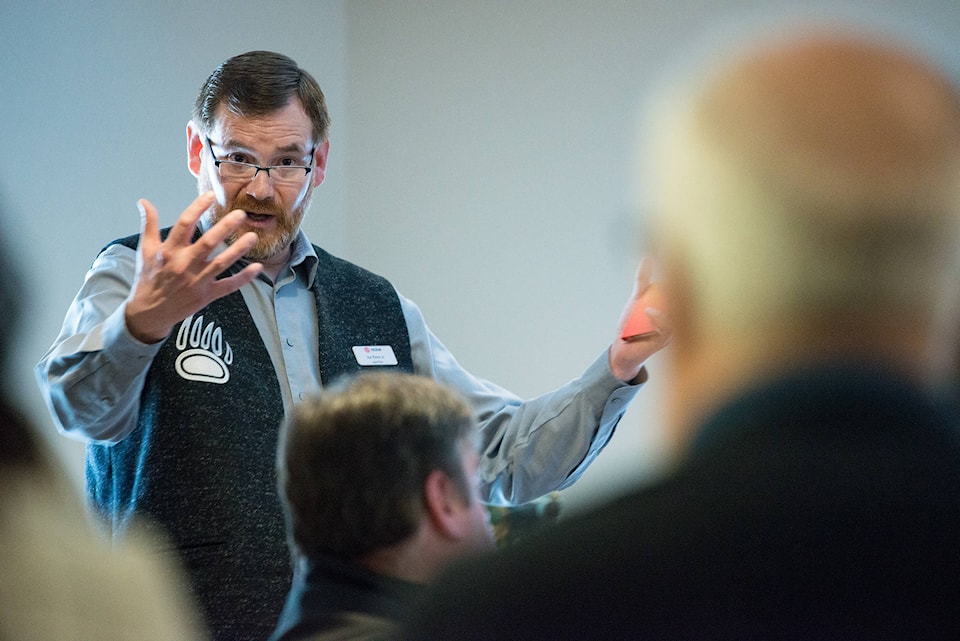Influential figures in Elk Valley governance gathered together in Sparwood to discuss how they can strengthen their relationship with the Ktunaxa Nation on Thursday, March 22.
Collectively, over 50 individuals agreed that the path to reconciliation is a long one, but together, possible.
This served as the first Community to Community Forum held in the Elk Valley; the first of many to come.
Still today, Indigenous Peoples are feeling the affects of residential schools. Even with reconciliation blanketed across Canada, the concept is still young.
Over the course of four hours, the Ktunaxa Nation, the Tobacco Plains Indian Band, the District of Elkford, the District of Sparwood, the City of Fernie, as well as several governmental, organizational and business chair members, shared their thoughts on how they can help heal the past, and create a positive future.
The Ktunaxa Nation has been present in the Elk Valley for approximately 11,000 years. Before settlers arrived from Europe, carrying with them their western views and ideologies, the Nation had long since established their own form of functioning government, and had a society with their own ethics, morals and philosophies. They made everything they needed; clothing, tools, and housing.
The traditional territory of the Ktunaxa Nation covers approximately 70,000 square kilometres within the Kootenay region of southeastern British Columbia and historically included parts of Alberta, Montana, Washington and Idaho.
Margaret Teneese, Archivist with the Ktunaxa Nation Council, gave an informative speech about the history of Ktunaxa Nation in the Elk Valley. She said that there are few ways that they as a people would lose the rights to their land, but one of these ways is through purchase.
“I’ve been working as an archivist for the Ktunaxa Nation Council for many years, and I have yet to come across a receipt that says Canada bought our territory,” said Teneese.
Another way is through an act of war, and Teneese stated that they have never been defeated.
“That’s [why] we believe we still have rights entitled to our territory,” she said.
In the mid-1800s the terrors inflicted upon Indigenous Peoples began. It took until 1996 to close every residential school in Canada. For the Ktunaxa Nation, the St. Eugene Mission closed its doors for good in 1970.
Many who attended the St. Eugene Mission are still alive today. Even the generation that followed felt the damage this residential school inflicted.
On June 11, 2008, Canada’s Prime Minister Stephen Harper apologized to Indigenous Peoples for the use of residential schools, and many saw this as the first step in a long healing process.
Today, First Nations government is challenged with the many social issues that remain in their communities. While many still feel the residual affects of the residential schools, alcoholism has spiked as many use it as a means to cope. This leaves government fewer resources to focus on infrastructure, education and development.
Today, communities and their local government are challenged not only with healing those wounds, but planning for a more positive future, while coexisting together.
An attendee at the C2C forum brought up the point that each societal group should be able to co-exist and practice their own culture. Additionally, communities living within the boundaries of first nations bands should be aware of the history that surrounds them.
Several leaders of local government proposed that communities are still not doing enough to inform and educate. They believe that true reconciliation starts in the school systems, and educating the youth in order to build a healthier future.
Additionally, members of local government agreed that embracing the history of the Ktunaxa Nation is a much-needed step in the right direction. For example, the Welcome to Fernie sign should have the traditional Ktunaxa name, ¢aqahak, written beside it.
“That’s why this could take a few generations,” said Fernie councilor Dan McSkimming. “Because it’ll be a long time before people can say, this is just normal, this isn’t something new.
“This is the new normal.”
Later this year, a municipal election will take place. City of Fernie manager of planning Patrick Sorfleet suggested that every new mayor and council member elected take part in a Community to Community Forum, in order to learn about the history of the Ktunaxa and build those relationships.
Members of the Ktunaxa Nation expressed interest in attending regional meetings such as the AKBLG, something they have been invited to in the past but with very short notice. This would be a step towards including the Nation more in local government.
Another suggestion was that those in the room keep in contact, reach out, and go for coffee; have one-on-one conversations about local government and start collaborating on a personal level.
“We are all colleagues here,” said ?aq’am Nasu?kin (Chief) Joe Pierre Jr.
On May 14, Justice Murray Sinclair will be continuing this conversation at the Key City Theatre in Cranbrook to talk about reconciliation and happiness. Sinclair was the first Aboriginal Judge appointed in Manitoba, and Canada’s second. He has served as Co-Chair of the Aboriginal Justice Inquiry in Manitoba and as Chief Commission of the Truth and Reconciliation Commission (TRC). He has been invited to speak throughout Canada, the United States and internationally.
